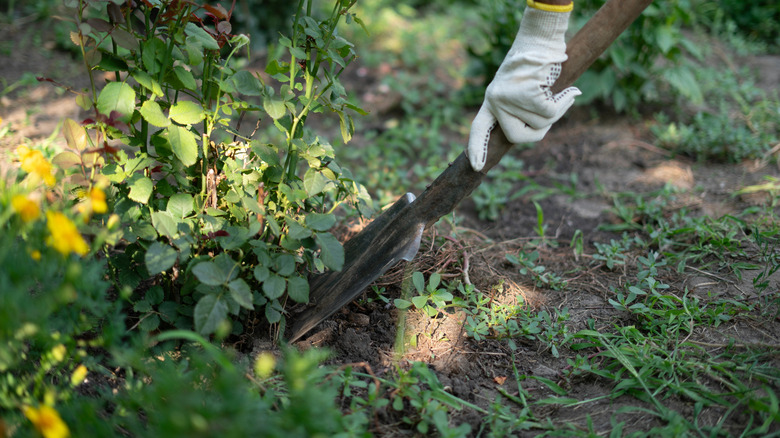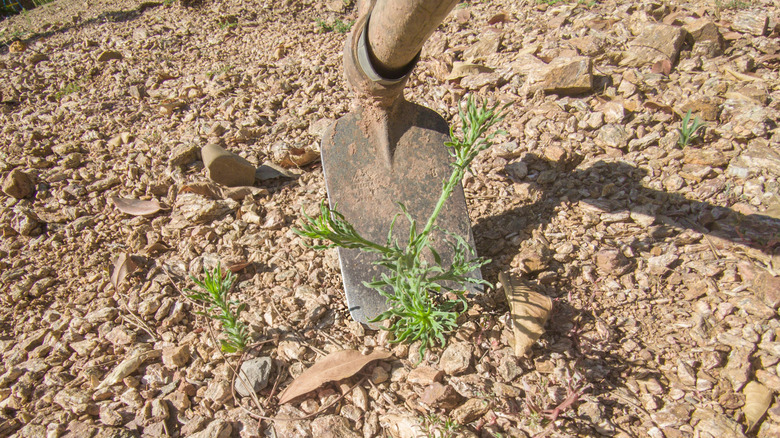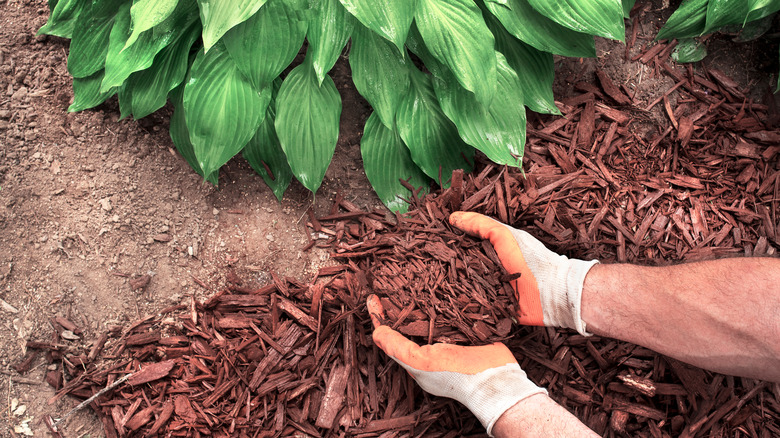Ditch The Shovel: 10 No-Dig Ways To Get Rid Of Weeds
Every gardener has to deal with dreaded weeds from time to time. These plants can spread through seeds that end up on your property in a variety of ways, including those leftover from previous seasons, the wind, and even bird droppings. Not only can weeds take over your lawn and garden plants, but they might create other undesirable effects as well. Established weeds can become safe-havens for unwanted pests, and they may possibly spread diseases to other plants, too. What's more, they can prevent grasses and other plants from getting enough necessary sunlight, rain, and nutrients needed to thrive.
Overall, weed control is a year-round task that requires careful attention, so it is essential to get rid of weeds in your garden and yard before they become larger issues. Detecting signs of weeds as early as possible saves a lot of work, but you also need to implement the right methods. Shoveling is sometimes used to deal with established weeds in large sections of a yard or garden, but this can also cause damage to the surrounding area. The purpose of a shovel is to dig out and remove materials, which may not be appropriate for getting rid of a few weeds here and there. Thankfully, you have many other options aside from using a shovel that don't require any digging whatsoever.
Use a garden hoe against weeds
A garden hoe is an essential tool that can also be used against shallow weeds. Unlike a shovel, a hoe has a narrower blade meant for breaking up materials rather than digging them out of the ground. Hoeing is considered an effective way to get rid of weeds, but proper technique is crucial in preventing further growth as well as nearby plant injuries. To use this method, strike the weeds with the hoe right at the edge of the soil level with short strokes only. Repeat a few times until the weeds fall off.
Pulling weeds by hand helps preserve other plants
Hand-pulling weeds is preferable if you're dealing with small weeds in fewer numbers, as well as those that are mixed in landscape beds or within a fruit or vegetable garden. Put on a pair of gardening gloves and pull one weed at a time. Concentrate your efforts towards the bottoms of each weed so you will effectively pull out the roots, too.
Use a garden fork or knife to assist weed-pulling
Pulling weeds by hand is generally effective against smaller weeds, but it can be a frustrating process when you keep pulling out the tops of the plants only. In these cases, you may need the assistance of a small garden fork or knife. Use these to loosen any remaining roots left in the soil so you can pull them out with ease.
Use a claw hammer for weed removal
A basic claw hammer can come in handy if you're looking for another no-dig trick for tackling weeds and don't have many gardening tools at your disposal. This technique works by using the claw side of your hammer to help pull stubborn weeds and their roots out of the soil. It's also similar to using a claw metal weeder, but without having to buy any extra tools. Simply apply the claw around the weed in question and yank upwards for easy removal.
Control weed growth with organic mulch
Mulch is a good way to help prevent moisture loss in certain plants. It can also prevent weed growth, too. Commonly recommended options include bark chips, grass cuttings, and pine straw. Just be sure to hand-pull any existing weeds before applying mulch around garden beds or individual plants, and ensure there are no weed seeds in the mulch itself.
Consider weed fabric as an extra barrier
Similar to mulching, weed fabric can provide a barrier against pesky weeds, reducing the need to dig these problematic plants out of the soil at a later date. These are especially beneficial for new landscape or garden beds. For best results, try a mesh-style fabric that can still allow plants to access water and nutrients.
Post-emergent herbicides may be required in certain cases
Chemical controls are generally regarded as last resort options for getting rid of weeds, and their use is usually discouraged in vegetable gardens. These commercial products have a place in certain cases of weed control, though, and they are most likely preferable to digging up your yard with a shovel. Consider a glyphosate-containing product for stubborn weeds, and carefully follow all manufacturer's instructions. It's also important to remember that post-emergent herbicides will not prevent future weed problems.
Apply pre-emergents to prevent weed growth
On the flipside, pre-emergent herbicides work to help prevent weeds around your yard or garden. You might find them especially helpful for annual weed control in large areas such as turfgrass. As their names suggest, these products must be applied before weeds germinate. These can help reduce the need for digging out weeds in the future, but such products ought to be used conservatively and with caution. If you decide to use pre-emergents in a vegetable garden, refer to the product label to make sure it's safe to do so.
Try corn gluten meal as a natural pre-emergent
If you're looking to say goodbye to weeds with a simple, natural solution, you might consider corn gluten meal. This corn-based product has similar effects to pre-emergent herbicides without all the added chemicals. Homeowners use corn gluten meal in their yards to prevent weeds, and it might also be used cautiously in vegetable gardens after plants are already established. For best results, apply corn gluten meal in early spring to help address weeds before they become problems.
Maintain a healthy yard and garden to keep weeds at bay
When you encounter weeds, your first reaction is to understandably find ways to get rid of them and prevent their future growth. Rather than solely focusing on getting rid of unwanted plants though, you can also reduce weed problems by focusing on the overall health of your yard and garden overall. Healthy grasses and plants have the capability to prevent weed growth, so make sure your yard and garden gets enough water and nutrients to stay competitive.










